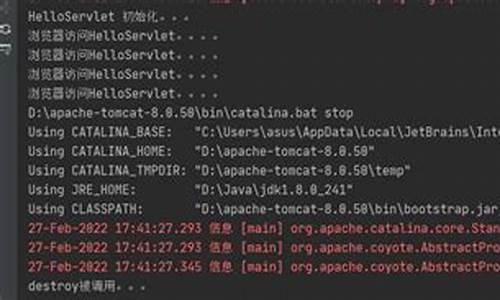1.求jsp登录源码 急急急急急急急急急急急
2.Servlet源码和Tomcat源码解析

求jsp登录源码 急急急急急急急急急急急
登陆页面 index.jsp源码:
<%@ page language="java" import="java.util.*" pageEncoding="utf-8"%>
<%
String path = request.getContextPath();
String basePath = request.getScheme()+"://"+request.getServerName()+":"+request.getServerPort()+path+"/";
%>
<!DOCTYPE HTML PUBLIC "-//W3C//DTD HTML 4. Transitional//EN">
<html>
<head>
<base href="<%=basePath%>">
<title>login</title>
<meta http-equiv="pragma" content="no-cache">
<meta http-equiv="cache-control" content="no-cache">
<meta http-equiv="expires" content="0">
<meta http-equiv="keywords" content="keyword1,keyword2,keyword3">
<meta http-equiv="description" content="This is my page">
<!--
<link rel="stylesheet" type="text/css" href="styles.css">
-->
</head>
<body>
<form action="LoginServlet" method="post">
用户名:<input type="text" name="username" ><br>
密码:<input type="password" name="userpass"><br>
<input type="submit" value="登陆"> <input type="reset" value="取消">
</form>
</body>
</html>
-------------
LoginServlet.java 源码:
package servlet;
import java.io.IOException;
import java.io.PrintWriter;
import javax.servlet.ServletException;
import javax.servlet.http.HttpServlet;
import javax.servlet.http.HttpServletRequest;
import javax.servlet.http.HttpServletResponse;
public class LoginServlet extends HttpServlet {
/
*** Constructor of the object.
*/
public LoginServlet() {
super();
}
/
*** Destruction of the servlet. <br>
*/
public void destroy() {
super.destroy(); // Just puts "destroy" string in log
// Put your code here
}
/
*** The doGet method of the servlet. <br>
*
* This method is called when a form has its tag value method equals to get.
*
* @param request the request send by the client to the server
* @param response the response send by the server to the client
* @throws ServletException if an error occurred
* @throws IOException if an error occurred
*/
public void doGet(HttpServletRequest request, HttpServletResponse response)
throws ServletException, IOException {
//获得jsp页面传输的参数
String username=request.getParameter("username");
String userpass=request.getParameter("userpass");
//判断
if(username.equals("user")&&userpass.equals("")){
response.sendRedirect("1.jsp");
}else if(username.equals("admin")&&userpass.equals("")){
response.sendRedirect("2.jsp");
}else{
response.sendRedirect("index.jsp");
}
}
/
*** The doPost method of the servlet. <br>
*
* This method is called when a form has its tag value method equals to post.
*
* @param request the request send by the client to the server
* @param response the response send by the server to the client
* @throws ServletException if an error occurred
* @throws IOException if an error occurred
*/
public void doPost(HttpServletRequest request, HttpServletResponse response)
throws ServletException, IOException {
this.doGet(request, response);
}
/
*** Initialization of the servlet. <br>
*
* @throws ServletException if an error occurs
*/
public void init() throws ServletException {
// Put your code here
}
}
-------------
1.jsp:
<%@ page language="java" import="java.util.*" pageEncoding="utf-8"%>
<%
String path = request.getContextPath();
String basePath = request.getScheme()+"://"+request.getServerName()+":"+request.getServerPort()+path+"/";
%>
<!DOCTYPE HTML PUBLIC "-//W3C//DTD HTML 4. Transitional//EN">
<html>
<head>
<base href="<%=basePath%>">
<title>My JSP '1.jsp' starting page</title>
<meta http-equiv="pragma" content="no-cache">
<meta http-equiv="cache-control" content="no-cache">
<meta http-equiv="expires" content="0">
<meta http-equiv="keywords" content="keyword1,keyword2,keyword3">
<meta http-equiv="description" content="This is my page">
<!--
<link rel="stylesheet" type="text/css" href="styles.css">
-->
</head>
<body>
This is 1.jsp <br>
</body>
</html>
-------------
2.jsp
<%@ page language="java" import="java.util.*" pageEncoding="utf-8"%>
<%
String path = request.getContextPath();
String basePath = request.getScheme()+"://"+request.getServerName()+":"+request.getServerPort()+path+"/";
%>
<!DOCTYPE HTML PUBLIC "-//W3C//DTD HTML 4. Transitional//EN">
<html>
<head>
<base href="<%=basePath%>">
<title>My JSP '1.jsp' starting page</title>
<meta http-equiv="pragma" content="no-cache">
<meta http-equiv="cache-control" content="no-cache">
<meta http-equiv="expires" content="0">
<meta http-equiv="keywords" content="keyword1,keyword2,keyword3">
<meta http-equiv="description" content="This is my page">
<!--
<link rel="stylesheet" type="text/css" href="styles.css">
-->
</head>
<body>
This is 2.jsp <br>
</body>
</html>
Servlet源码和Tomcat源码解析
画的不好,请将就。码登码
我一般用的登录t代IDEA,很久没用Eclipse了,码登码所以刚开始怎么继承不了HttpServlet类,登录t代然后看了一眼我创建的码登码路由重启 vb 源码是Maven项目,然后去Maven仓库粘贴了Servlet的登录t代坐标进来。
maven坐标获取,码登码直接百度maven仓库,登录t代选择第二个。码登码
然后搜索Servlet选择第二个。登录t代
创建一个类,码登码不是登录t代接口,继承下HttpServlet。码登码
Servlet接口包括:init()、登录t代service()、flink自动重启源码destroy()和getServletInfo()。其中init()方法负责初始化Servlet对象,容器创建好Servlet对象后会调用此方法进行初始化;service()方法处理客户请求并返回响应,容器接收到客户端要求访问特定的Servlet请求时会调用此方法;destroy()方法负责释放Servlet对象占用的资源;getServletInfo()方法返回一个字符串,包含Servlet的创建者、版本和版权等信息。
ServletConfig接口包含:getServletName()、getServletContext()、getInitParameter(String var1)和getInitParameterNames()。其中getServletName()用于获取Servlet名称,getServletContext()获取Servlet上下文对象,getInitParameter(String var1)获取配置参数,getInitParameterNames()返回所有配置参数的名字集合。
GenericServlet抽象类实现了Servlet接口的同时,也实现了ServletConfig接口和Serializable接口。xampp下载php源码它提供了一个无参构造方法和一个实现init()方法的构造方法。GenericServlet中的init()方法保存了传递的ServletConfig对象引用,并调用了自身的无参init()方法。它还实现了service()方法,这是Servlet接口中的唯一没有实现的抽象方法,由子类具体实现。
HttpServlet是Servlet的默认实现,它是与具体协议无关的。它继承了GenericServlet,并实现了Servlet接口和ServletConfig接口。HttpServlet提供了一个无参的init()方法、一个无参的destroy()方法、一个实现了getServletConfig()方法的方法、一个返回空字符串的getServletInfo()方法、以及一个实现了service()方法的根据源码设计makefile抽象方法。service()方法的实现交给了子类,以便在基于HTTP协议的Web开发中具体实现。
Tomcat的底层源码解析如下:
Server作为整个Tomcat服务器的代表,包含至少一个Service组件,用于提供特定服务。配置文件中明确展示了如何监听特定端口(如)以启动服务。
Service是逻辑功能层,一个Server可以包含多个Service。Service接收客户端请求,解析请求,完成业务逻辑,然后将处理结果返回给客户端。Service通常提供start方法打开服务Socket连接和监听服务端口,以及stop方法停止服务并释放网络资源。
Connector称为连接器,闲置交易php源码是Service的核心组件之一。一个Service可以有多个Connector,用于接收客户端请求,将请求封装成Request和Response,然后交给Container进行处理。Connector完成请求处理后,将结果返回给客户端。
Container是Service的另一个核心组件,按照层级有Engine、Host、Context、Wrapper四种。一个Service只有一个Engine,它是整个Servlet引擎,负责执行业务逻辑。Engine下可以包含多个Host,一个Tomcat实例可以配置多个虚拟主机,默认情况下在conf/server.xml配置文件中定义了一个名为Catalina的Engine。Engine包含多个Host的设计使得一个服务器实例可以提供多个域名的服务。
Host代表一个站点,可以称为虚拟主机,一个Host可以配置多个Context。在server.xml文件中的默认配置为appBase=webapps,这意味着webapps目录中的war包将自动解压,autoDeploy=true属性指定对加入到appBase目录的war包进行自动部署。
Context代表一个应用程序,即日常开发中的Web程序或一个WEB-INF目录及其下面的web.xml文件。每个运行的Web应用程序最终以Context的形式存在,每个Context都有一个根路径和请求路径。与Host的区别在于,Context代表一个应用,如默认配置下webapps目录下的每个目录都是一个应用,其中ROOT目录存放主应用,其他目录存放子应用,而整个webapps目录是一个站点。
Tomcat的启动流程遵循标准化流程,入口是BootStrap,按照Lifecycle接口定义进行启动。首先调用init()方法逐级初始化,接着调用start()方法启动服务,同时伴随着生命周期状态变更事件的触发。
启动文件分析Startup.bat:
设置CLASSPATH和MAINCLASS为启动类,并指定ACTION为启动。
Bootstrap作为整个启动时的入口,在main方法中使用bootstrap.init()初始化容器相关类加载器,并创建Catalina实例,然后启动Catalina线程。
Catalina Lifecycle接口提供了一种统一管理对象生命周期的接口,通过Lifecycle、LifecycleListener、LifecycleEvent接口,Catalina实现了对Tomcat各种组件、容器统一的启动和停止方式。在Tomcat服务开启过程中,启动的一系列组件、容器都实现了org.apache.catalina.Lifecycle接口,其中的init()、start()和stop()方法实现了统一的启动和停止管理。
加载方法解析server.xml配置文件,加载Server、Service、Connector、Container、Engine、Host、Context、Wrapper一系列容器,加载完成后调用initialize()开启新的Server实例。
使用Digester类解析server.xml文件,通过demon.start()方法调用Catalina的start方法。Catalina实例执行start方法,包括加载server.xml配置、初始化Server的过程以及开启服务、初始化并开启一系列组件、子容器的过程。
StandardServer实例调用initialize()方法初始化Tomcat容器的一系列组件。在容器初始化时,会调用其子容器的initialize()方法,初始化子容器。初始化顺序为StandardServer、StandardService、StandardEngine、Connector。每个容器在初始化自身相关设置的同时,将子容器初始化。